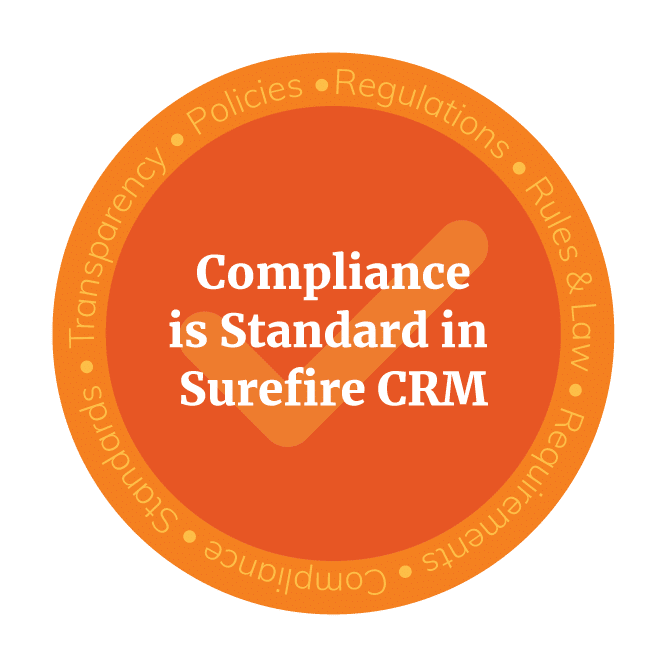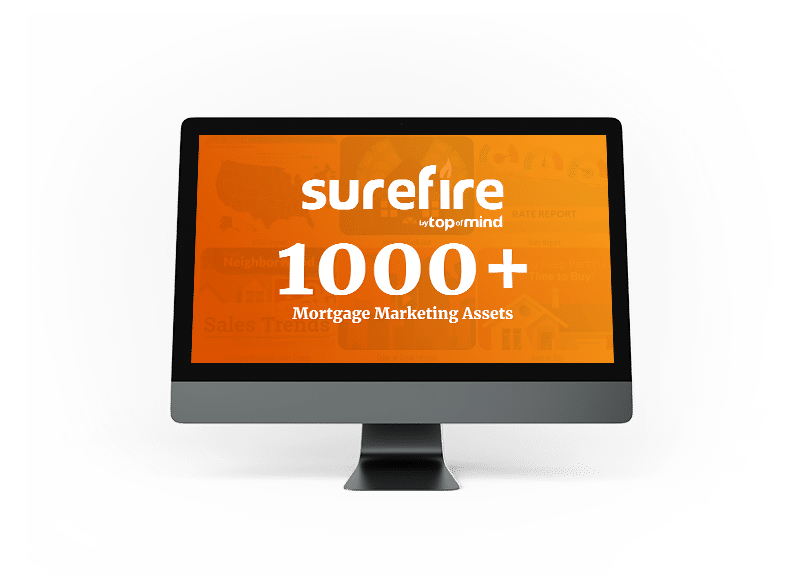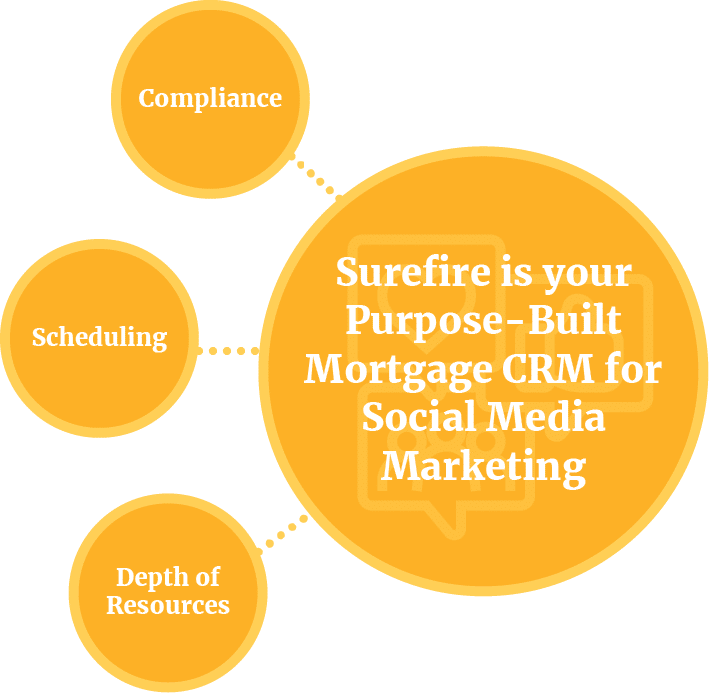How to Use Your CRM to Host a Successful Networking Event
Dec 20, 2023Networking events are an important way to begin and enhance working relationships with both potential clients and referral partners.

This article covers:

In addition to following the rules yourself, be aware that commenters on your posts could make non-compliant statements. You might consider turning off comments completely when that option exists. Otherwise, carefully monitor comments on your page and delete those that may be misleading. To avoid angering commenters, let your followers know you will hide comments that may violate mortgage lending advertising laws.
Be aware, too, that advertising on social media sites will look different for mortgages than for other consumer products. For example, Facebook requires mortgage lenders to create a “Special Ad Audience” that may be based on how the targets behave online, but not on potentially discriminatory factors like ZIP code or age.
Using a CRM created for the mortgage industry to create and schedule social media posts can help with compliance. For example, Surefire CRM allows companies to require approval for messages and also tracks posts for auditing purposes.
Get instant access to tried-and-true mortgage marketing strategies and guides with Mortgage Marketing University.
See how Surefire effortlessly develops content tailored to your brand. Sign up for a free look book today.
You have what it takes to be a top mortgage lender and Surefire has what it takes to get you there. Learn How!
If you want your social media followers to pause in their scrolling to look at your messages, then you probably know from your own experience that you’ll need to stand out in the crowd.
Here are some guidelines to remember whether you’re generating your own content or selecting messages from your mortgage CRM.

Mind your tone. Overall, social media is a place to be casual, and you’ll want your writing to be casual as well. You’ll want to remain professional, too, as everything you post is a reflection of your business. If you use humor, keep it rated G.
Address your audience. Take a look at who’s following you on different platforms. Facebook may have started out for college students, but it has long been popular with older generations, too. In general, newer platforms are more likely to have younger participants.
You may be able to determine who your audiences are by reviewing your lists of friends and followers. If not, pay attention to which types of posts gain traction on the various platforms. Do first-time buyer messages resonate more on Instagram, while refi messages get more likes and shares on Facebook?
Once you determine a pattern, you can begin to tailor your posts accordingly. However, you will not want to restrict certain topics exclusively to any one platform. Maybe most of your refi prospects are on Facebook, but you likely have some first-time homebuyers there, too. Plus, social media is all about sharing—even if your content isn’t relevant to some friends or followers, you hope they’ll share with friends who may be interested.
Stay relevant. Your business accounts should focus on your business, industry-related topics and the community you serve. Talk about your special products, the charity you support and your great team (with their permission). Leave most, if not all, of your personal posts for your personal pages.
One way to get personal without oversharing is to talk about your community involvement. Let people know you’ll be out supporting the hometown football team or that you’re planning to check out a community park since the weather has turned nice. These topics give your followers insight into your personal life while also showing your support for the community—a valued trait for many prospective borrowers.
Provide timely industry news. Did conventional loan limits recently increase? Did the FHFA report house prices are rising faster than ever? Are rates at historically low levels?
Help your friends and family members stay current on industry news, then go a step further to give context for the national headlines.
What do conventional loan limit increases mean for your community, especially if you’re in a pricey area? How does that help your typical homebuyer?
If house prices are rising nationally, does that mean they’re rising in your state or region too? How much have the prices grown and how much equity might that add for a typical homeowner? How will equity growth help your readers today, even if they aren’t planning to sell any time soon?
Rate news? We’ve heard about low rates for a while. Talk about how—specifically—low rates benefit your clients. Did you help someone save $500 a month with a refi? How much will they save over the life of their loan? Talk about it! (Avoid tagging clients in these cases, and definitely do not tag them without permission!)
Timely news is important in your social media marketing, and local context and/or success stories will make the news even more impactful. A strong mortgage CRM will provide timely messages and images. Grab those, then take it a step further and add a sentence or two to localize the information.

Even in normal times, people have problems to solve, though those problems might not be as universal as a pandemic. Are you seeing families post pictures as they tour college campuses with their high school students? Perhaps a post about using home equity to help pay tuition is in order. Are you or your friends preparing to take on some home improvements this summer? Maybe your followers are too. It’s a good time to share info on the FHA 203K.
Give your readers something to do. People love to play games, take quizzes and answer silly test questions on social media. You don’t want to share games that could compromise participants’ security. Instead, consider devising interesting interactions on your own.
For example, an easy way to engage followers is to ask questions related to homeownership. How long did you live in the first home you owned? What’s your favorite thing about your neighborhood? What’s your favorite or least favorite home maintenance chore? Whether people answer your question online or not, they will respond mentally, helping them associate your name with homeownership and financing topics.
Loan officers who use a mortgage marketing CRM likely have access to mortgage calculators, interactive games, and tools that can be used to encourage interaction on your social media channels. Surefire CRM has a series of neighborhood reports that allow readers to type in any street address and learn more about their area, from typical commutes to demographics to recent home sales. Loan officers can also share game show-style educational games, simple calculators, video riddles and more.
Include a call to action. You probably don’t want to end every post by saying, “Call me for a quote on your next home loan or refinance.” A call to action can be as simple as inviting your followers to like or comment on your post or encouraging them to use the cool calculator you posted. But, at least sometimes, you’ll want to remind them why you’re there—to make lives better through homeownership and home financing.
Posting timely news? “Comment below or reach out if you have questions.”
Posting about low rates? “I’ve helped many clients save money, even when they thought it might not be possible. Let me know if you’d like to see how much you may be able to save.”
Posting a pre-qualification calculator? “Even if you’re not purchasing a home right now, it’s fun to play with the simple calculator and see what you may be able to afford at this stage and with today’s rates. Try it out!”
No matter which platform you choose to use, content is key. If you want your social media followers to pause their scrolling to look at your messages you must provide consistent eye-catching content that follows industry regulations.
While managing your social media presence can feel overwhelming, there are tricks for making it easier. The largest and most comprehensive is a CRM platform that’s built specifically for the mortgage industry. Your CRM can help with your social media marketing in three primary ways: compliance, scheduling, and resources.
Compliance. A strong mortgage CRM will offer your company tools for reviewing and approving content deployed through the system. The company maintains control over which social media accounts are linked with the CRM and can deny or make edits for posts that don’t meet industry rules or are not on brand.
When auditors descend, a strong mortgage CRM will also be equipped with self-service tools so you can pull reports. Then, if auditors require more in-depth or unexpected details, you’ll have access to support that will help you answer the requests.
Scheduling. A key factor of success in social media marketing is consistency. Your followers need to hear from you regularly. As a result, if you let it get away from you, managing your accounts can turn into a full-time job. But your full-time job is supposed to be getting homeowners and home buyers into great loans. Who has time to be on social media all day?!
The ability to plan ahead and schedule out your posts is a key factor in making your social media marketing campaign work. You can set up recurring deployments to take care of weekly, monthly or annual messages.
For example, Surefire CRM provides a weekly market update. You set it up only once, and your followers will receive up-to-date messaging from you each week.
Recurring messages are also appropriate for market updates that occur less frequently or for regular reminders. Surefire CRM has a report you can schedule to appear on your social media feeds each quarter after FHFA releases its updated House Price Index.

Another strategy is to set aside time at the beginning of each year to schedule distinct messaging for that year. These might include fresh holiday wishes since you don’t want to use the same one each year. You can also pre-schedule messages that are evergreen, but that you don’t want to repeat annually. Examples might include mortgage calculators, credit riddles, or interactive games.
Before you know it, your social media marketing will primarily be a set-it-and-forget-it machine. You can hop in with timely news occasionally, but overall, your social media posting will take care of itself with a little set up from you.
Depth of Resources. It’s impossible to schedule social media marketing posts out for a year or longer without a broad content library. Your mortgage CRM should contain a full catalog of content options, covering the breadth of mortgage-related topics, presented in a variety of styles, and available to distribute through several avenues, including social sharing. This way, you’ll find something you like, messaging that is on-point, and content that’s bound to make you stand out from your competitors.
We may think of physical libraries as stale, quiet, musty places, but your mortgage CRM’s content library should not be! In fact, it should be downright noisy with announcements of new and updated resources. You should be wowed constantly by timely messages, fresh styling of evergreen messages, and new ways to invite interaction and engagement.
In 2020, during the first six months of the pandemic, Surefire CRM’s creative team released 25 timely messages to help loan officers communicate clearly about changes impacting the market. During that time, Surefire CRM also released re-styled and updated designs for in process communications, several mortgage calculators, and the weekly markets newsletter.
Social media marketing should work for you, not the other way around.
With a strong mortgage CRM at your back, social media marketing will become a fun and easy part of your job. You’ll put your social media accounts to work for you bringing in new business, rather than working for your social media accounts as you try to manage your posts.
Surefire CRM can help you with social media and more. We would love to give you a tour!
Networking events are an important way to begin and enhance working relationships with both potential clients and referral partners.
Ad conversion rate measurement helps LOs gauge the effectiveness of their marketing spend. Surefire mortgage CRM can boost those metrics.
Credit union marketing strategies can benefit significantly if marketers utilize content designed from the start to foster engagement.